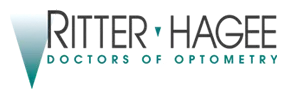Lens Manufacturing
Optical lenses are customized to match your refractive error and face shape. The process begins with a round button of plastic called a blank. At an off-site lab, this blank is ground to a specific power. This blank may be made of any number of materials, each having its own properties. For example a type of plastic called CR-39 tends to have excellent optical qualities but is slightly bulkier. Polycarbonate and Trivex tend to be thinner, more lightweight, and have improved impact-resistance. This makes these polymers excellent for usage in thick prescriptions, or for sports or safety glasses. While less common, glass lenses have some of the sharpest optics available, but are very heavy and can shatter if struck hard enough. Glass is usually used more in telescopes, camera lenses, and binoculars.
Once your power is ground into the blank, it is sent to our on-site finishing lab. We use a computerized edger to custom grind and bevel the lens to fit into its new home, your eyeglass frame.
Here are some additional considerations you may want to make before determining what you want from your new eyeglasses:
Photochromic Lenses
Photochromic lenses have the ability to rapidly change from clear indoor lenses to darkened sunglasses as you step outside. This does away with the need for separate pairs of eyeglasses and sunglasses. Recent breakthroughs have allowed these to be produced in almost any material including lightweight polycarbonate materials and the thinnest high index lenses. The lenses are activated by ultraviolet light and will remain dark until the UV light exposure is over. They are a fantastic option for children as well, as they provide excellent protection against the potentially vision-damaging rays of the sun.
High-Index Lenses:
For those who tend to reach the higher limits of prescription power, think “high-index lenses”. This special type of plastic refracts light more efficiently, allowing your lenses to be produced with the thinnest edges possible while preserving superior optics. You can finally toss out those old “Coke-bottle” eyeglasses!
Anti-reflective (AR) coatings:
Breakthroughs in physics have allowed scientists to produce a lens coating that can significantly reduce the amount of glare that reaches the eyes from extraneous light sources. This can greatly cut down on eyestrain while working on a computer or driving at night by eliminating annoying reflections from overhead lighting and unwanted haloes around headlights. There is a certain cosmetic benefit as well; other people will see more of the color of your eyes instead of random reflections. Similar coatings are often used in photographic lenses, computer monitors, televisions, and telescopes.
Lens Tints:
Our laboratory has the ability to add any amount of brown, gray, amber, or rose tint to either your new or old lenses. This is a great way to transform your old eyeglasses into your new prescription sunglasses very quickly and inexpensively.
Scratch Coating:
A high quality coating is provided to help protect from routine wear and tear on your lenses. Some lens materials will have this built in.
Ultraviolet Coating:
A coating is provided on the lens to absorb the damaging UV rays from the sun. A lifetime of UV exposure has been shown to contribute to the formation of cataracts, macular degeneration, eye skin wrinkles and even tumors.
